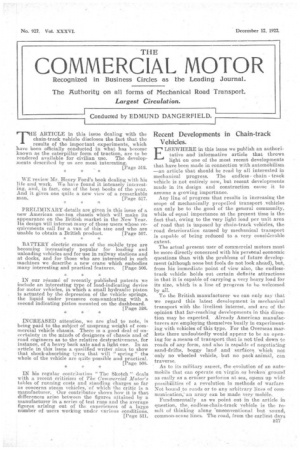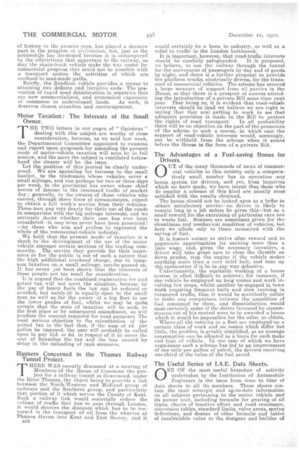Recent Developments in Chain-track Vehicles.
Page 1

Page 2

Page 3

If you've noticed an error in this article please click here to report it so we can fix it.
ELSEWHERE in this issue we publish an authoritative and informative article that throws light on one of the most recent developments that have been made in connection with automobilism —an article that should be read by all interested in mechanical progress. The endless chain track vehicle is not entirely new, but reeent developments made in its design and construction eause it to assume a growing im,portance.
Any line of progress that results in increasing the scope of mechanically propelled transport . vehicles can only be to the good of the general community, while of equal importance at the present time is the fact that., owing to the very light load per unit area of road that is imposed by chain-track vehicles, the road deterioration caused by mechanical transport is capable of being reduced to a very considerable extent.
The actual present user of commercial motors must be more directly concerned with his persarnal economic questions than with the problems of future development (although none but fools do not look ahead), but, from his immediate point of view also, the endless track vehicle holds out certain definite attractions in that it is capable of carrying a very heavy load far its size, which is a line of progress to he welcomed by all.
To the British manufacturer we can only say that we regard this latest development in mechanical transport with the liveliest interest, and are of the opinion that far-reaching developments in this direction may be expected, Already American manufacturers are employing themselves busily in experimenting with vehicles of this type. For the Overseas markets there undoubtedly would appear to be an opening for a meant of transport that is not tied down to roads of any form, and also is eapable of negotiating sand-drifts, boggy land and surfacea Which not only no wheeled vehicle, but no pack aninial,. can traverse.
• As to its military aspect, the evoiution of an automobile that can operate on 'virgin or broken ground as easily as a cruiser performs at sea, opens up wide possibilities of a revolution in methods of warfare Not hound to roads or to any arbitrary lines of communication,' an army can be made very mobile.
Fundamentally as we point out iii the article in question, the. endless-chain-track vehicle is the result of thinking along 'unconventional hut sound, common-sense lines. The road, from the earlie4 daya
of history to the present time, has played a decisive part in the progress of civilizatioo, but, just as the automobile has developed because it is unhampered by the restrictions that appertain to the railway, so may the chain-track vehicle make the.svay easier for commercial progress that could not be possible with a transport system the activities of which are confined to man-mado paths. Briefly, the Roadless vehicle provides a means to attaining two definite and lucrative ends: The prevention of rapid road deterioration in countries that are now commercialized, and economical expansion of commerce in undeveloped lands. As such, it deserves closest attention and encouragement..
Motor Taxation : The Interests of the Small Owner.
THE TWO letters in our pages of " Opinions " dealing with this subject are worthy of close consideration, because, as we said last week, the Departmental Committee appointed to examine and report upon proposals for amending the present mode of motor-vehicle taxation will soon be in full session, and the more the subject is ventilated beforehand the clearer will be the issue.
Let the position of this journal be clearly understood. We are appealing for fairness to the small haulier, to the tradesman 'whose vehicles cover a small mileage, and run perhaps for two or three days per week, to the provincial bus owner whose chief source of income is the increased traffic of market day ; generally, to the owners of those vehicles who cannot, through sheer force of circumstances, expect to obtain a full week's service from their vehieles. These men pay very dearly for their use of the roads in comparison with the big mileage interests, and we seriously doubt whether their case has ever been considered—it may 'even never have been presented! —by those who aim and profess to represent the whole of the eommercial-vehiele industry. We hold that the present modeof taxation is a check to-'the development of the use of the motor vehicle amongst certain sections of the trading community. The .service they provide for their customers or for the public is not of such a nature that the high additional overhead charge, due to lumpsum taxation on.a small mileage, carobe passed on. It has never set been shown that the interests of these people are too small for consideration.
It is argued that the combined registration fee and petrol tax will not meet the situation, because by the use of heavy fuels the tax can be reduced or avoided, but surele6it is equally open to the small man as well as.for the owner of a big fleet to use the Lower grades of fuel, whilst we may be quite. certain that the scale of taxation will be such, in the first place or by subsequent amendment, as will produce the amount required-for road purposes. The most serious objection to the reinstitution of the petrol tax is the• feet that, if the sum of 4d. per gallon be imposed, the user will probably be called upon to pay 54d. or 6d. in respect of. it to cover the cost of financing the tax and the loss caused by delay in the unloading of tank steamers.
Hauliers Concerned in the Thames Railway Tunnel Project.
THERE WAS recently discussed at a meeting of Memberssof the House of Commons the project for a railway tunnel at Gravesend, under the River Thames, the object being to provide a link between the NorthAVesteen and Midland group of railways and the Southern group, and particularly that portion of it which serves the County of Kent. Such a railway link would materially reduce the volume of traffic that has to pass through London, it would shorten the distance which has to be traversed in the transport of oil from the wharves at Thames Haven into Kent and East Surrey, and it
B18 would certainly be a boon to industry, as well as a relief to traffic in the London bottleneck.
It is important, however, that road-traffic interests should be carefully safeguarded. It is proposed, we believe, to use the railway through the tunnel for the conveyance of passengers by day and of goods by night, and there is a further proposal to provide low platform &nag, electrically driven, for the transport of commercial.vehicles. The scherne'has secured a large measure of support from all parties in the House, so that there is a prospect di success attending the introduction of a private Bill some time next year. That being so, it is evident that road-vehiele interests should be (and we believe we are right in saying that they are) getting to work to see that adequate provision is made in the Bill to protect the rights of road transport. In all probability there will be no objection on the part of the promoters of the scheme to such a course, in which case the support of read-vehicle interests would, seemingly, not be withheld from the scheme when it comes before the House ia the form of a private Bil.
The Advantages of a Fuel-saving Bonus for Drivers.
0 UT of the many thousands of users of commercial vehicles in this country only a comparatively small number has in operation any bonus system for drivers, and yet, from inquiries which we haVe made, we have learnt that those who do employ a scheme of this kind are usually most satisfied with the results obtained.
The bonus should not be looked upon as a bribe to obtain satisfactorT service—no driver is likely to remain long in a job unless he gives this—but as a small reward for the exercising of particular care not to waste fuel. Bonuses are sometimes given for the cleanliness and mechanical condition of vehicles, but here, we allude only to those .connected with the saving of fuel. It is human nature to strive after reward and to appreciateopportunities for earning more than a bare wage, and, given the necessary incentive, a driver will take great care to close the throttle on down grades, stop the engine if the vehicle makes anything more than a very brief halt, and tune up the carburetter if it be in any way defective. Unfortunately, the equitable working of a bonus system is often difficult to achieve ; for instance, if one vehicle be employed on long routes and work involving few stops, whilst another be engaged in town work requiring frequent halts and slow running in congested traffic, then it would be manifestly unfair to make any comparison between the quantities of fuel consumed by them, and dissatisfaction would most certain& ensue if the driver favoured by circumstances out of his control were to be awarded a bonus which it kvould be impossible. for the other to obtain.
Where;a11 the vehicles in a fleet are employed"on a certain class of work and on routes which differ but little, the problem is greatly simplified, as an average consumption can be adopted as a basis for each make and type of vehicle. In one case of which we have cognizance such a scheme has led to an improvement of one mile per gallon of petrol, the drivers receiving one-third of the value Of the fuel saved.
The Useful Series of I.A.E. Data Sheets.
oNE OF the most useful branches of activity undertaken by the Institution of Automobile Engineers is the issue from time to time of data sheets to all its members. These sheets Contain the mest accurate and up-to-date information on all subjects pertaining to the motor vehicle and its power unit, including formulte for gearing of all types, charts of tractive effort and road resistance, conversion tables, standard limits, valve areas, spring deflections, and dozens of other formulae and tables of incalculable value to the designer and builder of
all types of motor vehicles. Much of this information has never before been available, and certainly not in the concise form in which it is now presented.
The value of the data sheetsis enhanced by the fact that they are arranged for indexing, and are perforated for fitting into the special binders also supplied by the Institution, Those who are not members of the I.A.E. may obtain the .sheets from the secretary of the Institution, 28, Victoria Street,
London, S.W. 1, at the price of 3d. each; the binders may also be obtained on application. We consider that the-Institution is to be heartily congratulated upon taking the initiative in this matter, and the policy is one which ,might well be adopted by similar bodies. There is no doubt that the " " spirit displayed will do much to cause a large increase in the membership, which is already considerable, and is growing steadily.






























